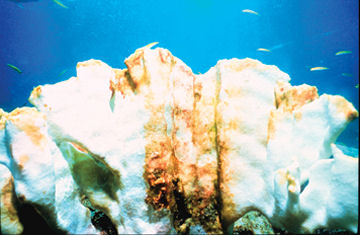Most of the variation in the amount of Caribbean coral that turns sickly pale each year is driven by two counteracting forces, a new analysis shows. They are the periodic ocean heating from the climate phenomenon known as El Niño and the occasional cooling action of sunlight-blocking particles high in the atmosphere.

When ocean temperatures rise even slightly, some species of corals shed the brightly colored algae that live within them, a sometimes-reversible change known as coral bleaching (SN: 8/28/04, p. 142: Available to subscribers at Some corals like it hotter). If bleaching episodes last weeks or months, coral colonies can die, says Jennifer A. Gill, an ecologist at the University of East Anglia in Norwich, England.
Gill and her colleagues reviewed other scientists’ field observations made from 1983 to 2000. Coral bleaching peaked in the Caribbean in five of those years: 1987, 1990, 1995, 1998, and 1999.
El Niños boosted water temperatures in 1987, 1998, and 1999. During an El Niño, sea-surface temperatures in the tropical Pacific are warmer than average. That region isn’t directly connected with the Caribbean, but changes in worldwide weather patterns cause waters to warm in the Caribbean as well, says Gill.
Caribbean coral bleaching noted in 1990 and 1995 didn’t occur during El Niño years, hinting that another factor was at play. Those years were marked by fewer tiny particles in the atmosphere than in other years. That material, called aerosols, often includes bits of ash that spread worldwide from major volcanic eruptions.
In contrast, even though there was an El Niño in 1991, the cooling effect of Mount Pinatubo’s eruption in the Philippines that year prevented extensive coral bleaching, says Gill.
The team concludes that the balance between El Niños and aerosols in the atmosphere accounts for about 70 percent of the year-to-year differences in Caribbean-coral bleaching. The researchers report their findings in the Dec. 5 Proceedings of the National Academy of Sciences. The analysis suggests that a 10 percent drop in aerosols results in a 36 percent increase in the area affected by coral bleaching if all other factors are the same.
“If dust declines, reefs are in trouble,” says Gill.
El Niños not only raise the water temperature in the Caribbean but also tend to diminish the winds there. That’s “a double whammy,” says Clive Wilkinson, an ecologist at the Reef and Rainforest Research Centre in Townsville, Australia. Slow winds hold fewer sun-blocking aerosols and carry them shorter distances than strong winds do, he notes. Then, the increased radiation that reaches sea level is readily absorbed by calm water.






